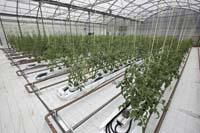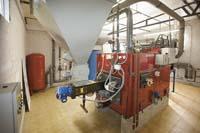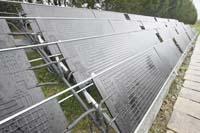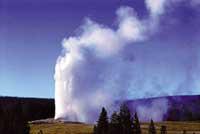Renewables in greenhouses
2009/01/01 Kortabitarte Egiguren, Irati - Elhuyar Zientzia Iturria: Elhuyar aldizkaria

When we talk about alternative energy sources, we talk about alternative energy sources to fossil fuels. Currently, the energy supply is mainly based on the combustion of fossil fuels. The use of alternative energies has a double objective in greenhouses: on the one hand, they aim to reduce the energy costs of greenhouses and, on the other, reduce the environmental impact.
In this line, Neiker- Tecnalia has launched in Derio an air-conditioned greenhouse with alternative energies. In this initiative, for the first time a biomass boiler has been combined with thermodynamic solar panels for the production of a greenhouse. Also, the Provincial Council of Gipuzkoa will launch a greenhouse that will be heated with geothermal energy in the Natural Park of Pagoeta in Aia.
Biomass
In the greenhouse of Derio they have two great challenges. "On the one hand, we want to reduce costs, since the price of traditional fuels is very high, and on the other hand, we want to improve the yield and quality of the harvest. In this way, we will be able to offer our own products from a time of year", explains Patrick Riga, researcher at Neiker-Tecnalia.
Biomass boilers use wood and other organic waste as fuel, generating a power of 400 kW -- the highest power used to date for greenhouse air conditioning.
"They are ecological boilers, that is, they work with organic remains such as almond shells, olive bones, pellet, sawdust, etc. ", he adds. From the trucks the pellet is discharged to a silo. Then, by means of a mechanism called an auger of this silo, the furnace is automatically fed with pellet. The heat generated by this oven can heat the water to 80-90 degrees Celsius, which warms the greenhouse air through several ground ducts.

"The energy obtained from these biomass boilers is cheaper than that obtained from any boiler fed with fossil fuels such as oil, natural gas or propane," said Riga. Technology also has a lot to say. In fact, a few years ago the efficiency of the boilers was, at most, 70%. Currently its efficiency is 90-95%. They have improved a lot.
Solar energy
As for thermodynamic solar panels, water cannot be heated as much as with the boiler, but is stored at 45-50ºC. This water is carried from several polyethylene pipes to the substrates of the greenhouse. "In short, the goal is to heat the roots. That is, we heat our feet to the plants," says Riga.
Thermodynamic solar panels work in a closed circuit. The system consists of a compressor and a heat exchanger. This system consists of the incorporation of a low temperature gas, that is, in its liquid phase, and its dispersion through the circuit of thermodynamic solar panels. When heating the plate, this liquid becomes gas. This gas then returns to the compressor. There the gas compresses, returns to the liquid phase and heat is generated. This heat passes through the heat exchanger and the water to be used to heat the greenhouse is heated. It is a system of high energy efficiency, since for each kW used are generated between 3 and 8 kW.
This system also significantly reduces carbon dioxide emissions into the atmosphere. According to Riga: "In a gas-heated greenhouse between 28 and 77 tons of CO 2 per thousand meters are emitted into the atmosphere. It's a lot. However, the use of thermodynamic plates prevents the emission of carbon dioxide into the atmosphere if clean electrical energy is used."
Combining both types of energy they manage to heat the water and temperate the greenhouses. This results in an optimal temperature inside the greenhouse. We obtain the conditions that plants would have in their natural time of production and that can bear fruit continuously.

In addition, by reducing consumption spending and making a seasonal harvest available throughout the year, the price of the final product decreases considerably. Moreover, this system can offer the possibility of competing with products imported from abroad, even if it is not the right time for that harvest.
"At the moment in this greenhouse of Derio we produce tomatoes and peppers throughout the year and from now on we will decide which products are manufactured," says Riga. "We are currently working on combining different alternative energy sources in order to get the best result. Therefore, I still cannot say that one type of energy is better than the other. In fact, when choosing the most suitable type of energy you have to take into account the objectives of the agrarian company and its location. For example, in sunny countries, solar panels are certainly a great opportunity," he said.
The heat of the earth
The greenhouse that the Provincial Council of Gipuzkoa has recently built in the Natural Park of Pagoeta in Aia, will be heated with geothermal energy. Ornamental plants will grow in this greenhouse. They want the minimum temperature of the greenhouse to be 5°C. Keep in mind that in these places winter temperatures are also -5º C.
This system extracts energy from the soil. The energy is transformed into heat and transferred to the accumulator. In this way, approximately 75% of the necessary energy will be obtained from the soil heat. "Three quarters of the energy will be obtained from the soil, approximately. The rest will be collected in an electric grid", explains Iñaki Puga, Sustainable Development technician of the Provincial Council of Gipuzkoa.

Therefore, the geothermal heat pump takes off much of the energy needed to heat the greenhouse. The heat extracted from the soil and the mechanical work performed by the system compressor will be used to heat the greenhouse. Thus, by absorbing 10,600 W of electricity from the grid, this system offers the greenhouse 45,900 W of useful heat.
The system has a high yield coefficient (COP) of 4.4. The performance coefficient of the most powerful systems is 7. In addition, because the temperature changes that the soil undergoes throughout the year are not very high, the installation works continuously at optimum performance. "We are retouching last minute and we hope that this month or February will be underway," adds Puga.
Biomass, thermodynamic solar panels and geothermal energy are alternative energy sources to fossil fuels, which together with many others must help overcome dependence on fossil fuels.

Gai honi buruzko eduki gehiago
Elhuyarrek garatutako teknologia





